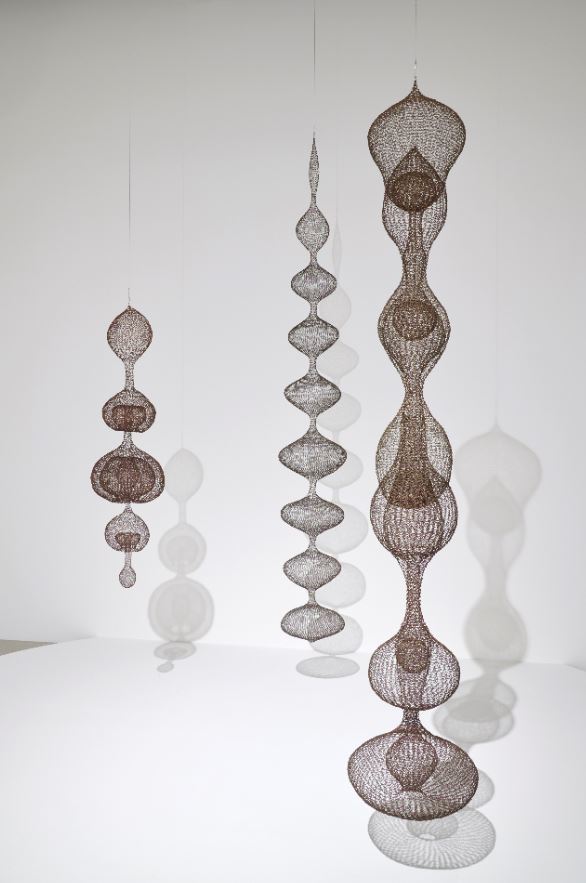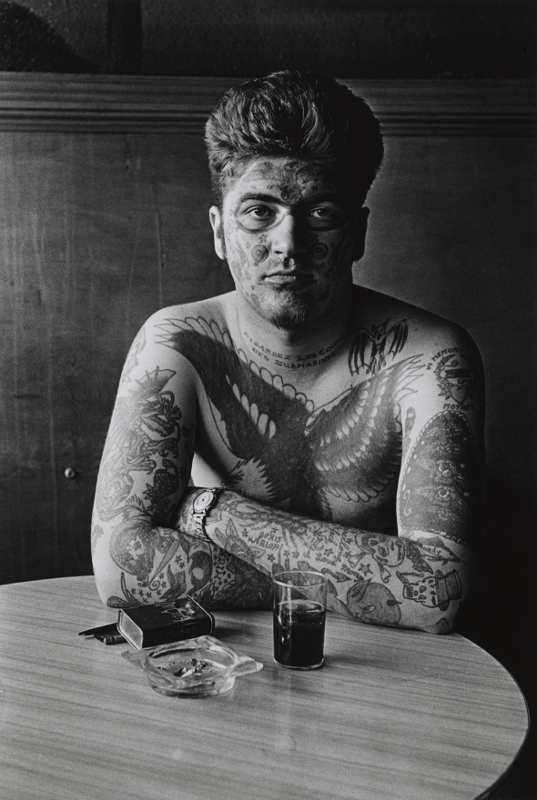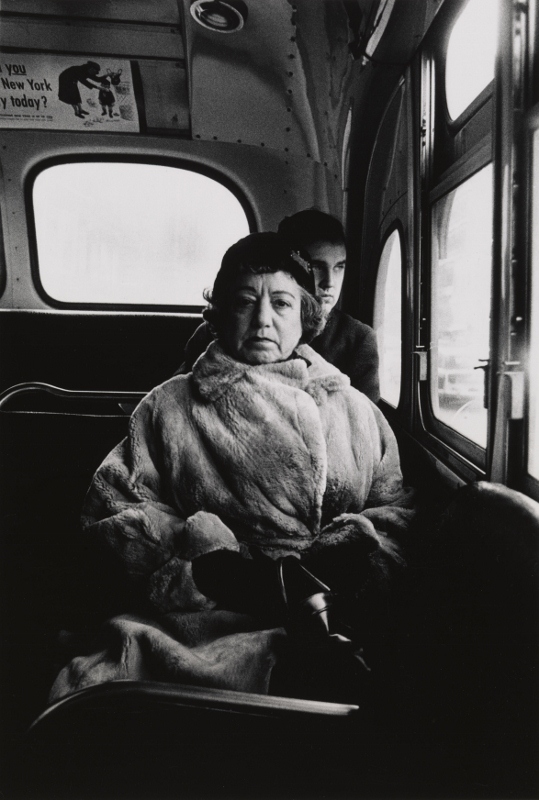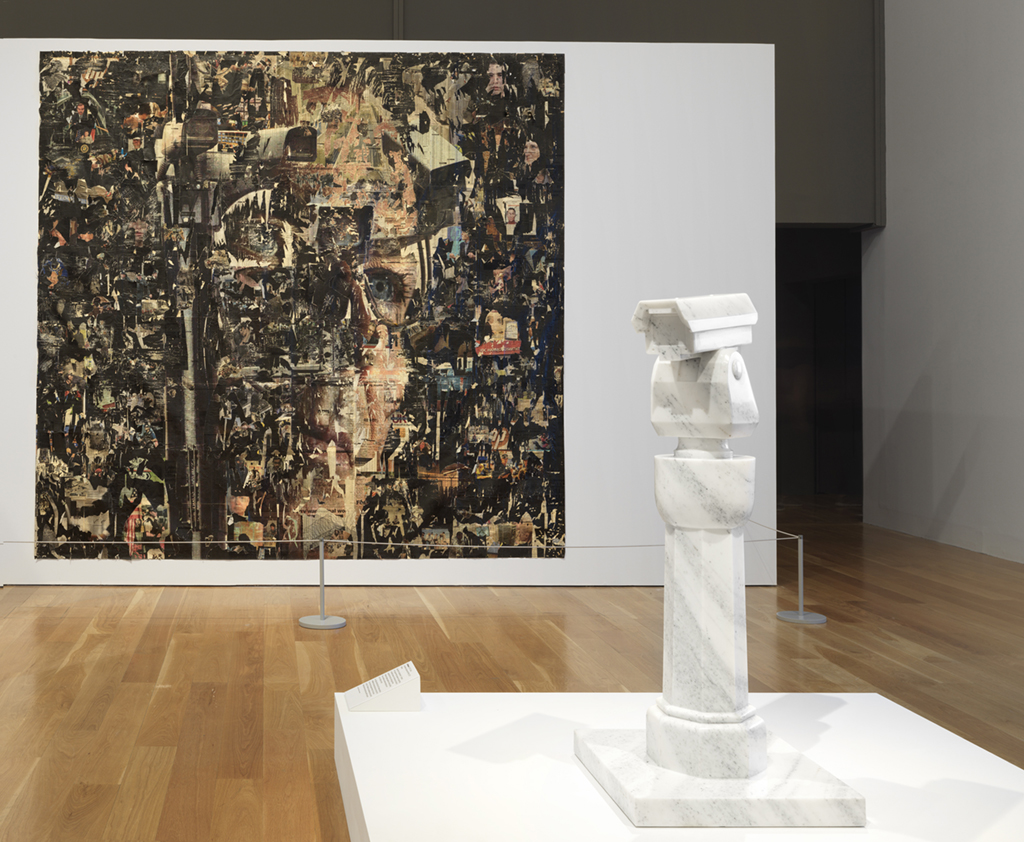This is a great, a really great exhibition. I came out wreathed in smiles, hesitated a moment, then went back in and did the whole thing all over again. And I wasn’t the only one enjoying it – it was packed, very noticeably with young families with prams and crawling babies and toddlers and junior school-aged kids. This is unusual at London art galleries which are generally full of doddering grey-haired old seniors. Word has somehow gotten around about what fun it is!
Planet organic
Why? Well, it’s billed as a massive survey of abstract, organic sculpture featuring the work of 21 international artists from the past 60 years. Obviously the broad term ‘sculpture’ can include realistic depictions of people and animals, depictions of buildings or manufactured objects, along with all manner of angular modernists creations. But all those possibilities and visions have been omitted as the curators have chosen works expressly designed to convey the shapes and forms and motions of organic life.
Bubbling foam and shiny baubles, hanging mesh and oozing tubes, wormlike mouldings and flying tutus, pendulous eggs and looping strands, tenuous tendons and metallic tangles, hidden claws and giant talons, all the works have been chosen for the way they capture, suggest, echo, are based on the endlessly moving, changing, bubbling, proliferating forms of organic life.
It’s a show of (mostly static) works which, however, suggest movement, melting, flux and floating, congeries and conglomerations, a continually impressive collection of sculptural forms that seem to ooze, undulate, blossom, erupt and sprawl all over the gallery space and beyond.
The drag of political art
Many if not most modern art exhibitions are highly themed and conceptualised – many are overtly political and polemical, such as the current exhibitions at the Barbican (the politics of textiles), Tate Britain (Women in Revolt!) and Dulwich Picture Gallery (Black artists’ takes on the genre of landscape painting).
Art works in those kinds of shows are more often than not chosen to make a political point and so are accompanied by baleful and grim text labels, ramming home the curators’ woke concerns. (I’m not using ‘woke’ in a general derogatory sense but in its original dictionary definition of ‘alert to racial prejudice and discrimination’, which is exactly what the Barbican and Dulwich shows are at pains to be.)
The joy of fun art
Anyway, that’s all by way of explaining that this show comes as quite a relief from the relentless preaching of art curators, because it is actually about art, just art, just the expression of forms and shapes for their own sake, for the fun of exploring and playing.
It feels playful. It feels fun. The promotional photos show small children looking in awe at a huge agglomeration of metal balls (‘Untitled’ by Tara Donovan) or two giant carrot shapes (‘Tunnel Boring Machines’ by Teresa Solar Abboud), and a child’s perspective is entirely appropriate to get the most from the wonderful shapes and vibrant colours on display – to the flying skirts (DRAFT) and bubbling foam (Michel Blazy) and funny sounds and neon constructions (E.J. Hill) and huge blobs and massive pink fabric worms (Eva Fàbregas) and big blob of metal lava (Lynda Benglis) and dangling fabrics (Ernesto Neto) and looming dolmen (Phyllida Barlow).
We are, just occasionally, allowed to stop feeling guilty about our part in the slave trade or institutional misogyny; we are allowed to relax and let our minds frolic and sport around and under and into weird and wonderful shapes, to be let off the leash of society’s endless worrying about ‘issues’ and let the carefree mind rediscover the primal joy of shapes and patterns created for our delight – and this is the exhibition to do it at!
It’s a welcome reminder that art can actually be carefree and fun, strange and mysterious, teasing and tantalising. For once I felt like I was visiting an exhibition of art designed to uplift and inspire me instead of attending my company’s compulsory course on inclusion and diversity.
We are allowed to smile. We are allowed to laugh out loud. We suddenly remember something we’d forgotten amid the stern and serious lecturing of those other exhibitions, that art can be liberating and light and frolicsome and funny. I’m smiling. Give yourself a treat.
Engineering
Buried in the layout is a form of chronological order, and you could take it that way, studying the wall labels to follow changing looks and trends from the 1950s onwards. But what this approach highlights is not so much developments in the artistic imagination as in technology and engineering. In each successive decade you can see how technological developments in moulding and shaping, erecting and supporting, above all in the variety and malleability of a steadily increasing diversity of materials, allowed artists’ imaginations to bloom and expand.
Gallery
Here’s a gallery of some of the most striking works and, as I increasingly do, I’ll add in the curators’ own wall labels about them. These are italicised to make it crystal clear they are not my words.
Tara Donovan
Tara Donovan makes her sculpture from manufactured materials that are often a part of consumers’ everyday lives but she finds her primary inspiration in nature. Untitled (Mylar) is created from thousands of flat, reflective discs of Mylar (a metallic polyester film), which have been folded, hot-glued and massed into spheres of varying sizes. Together they form a gigantic agglomeration that appears to mimic the growth patterns of biological or molecular structures. As always in Donovan’s work, light is an important factor, which she thinks of as an additional material, generating kaleidoscopic perceptual shifts of reflectivity as the viewer moves around the installation.
Eva Fàbregas
‘My work aims to fully inhabit the world of the senses, to imagine other possible bodies, other ways of feeling, caring and being in the world.’
A trio of massive inflatables crawls across the exhibition space. Made from stretched fabric and inflated balls, these tangled, pulsating forms appear distinctly intestinal. The sculptures are like instruments, activated by a choreography of subsonic frequencies, elastic rhythms, and textural sounds. The bass-heavy soundtrack is inspired by the artist’s experience of sound systems in nightclubs; Eva Fàbregas intends for the low audio frequencies in her work, emitted by multiple subwoofers, to be felt and not just heard. We resonate together with the sculptures, recalling forms of communication that occur inside us – at a cellular level – and between our bodies and the world.
Marguerite Humeau

Installation view of ‘The Guardian of Ancient Yeast’ by Marguerite Humeau (2023) Photo by Jo Underhill
‘There are forms of life that will survive us. How can we take them as our guides or companions to understand how to navigate our own futures?’
The sculptures in this room by Marguerite Humeau evoke forms that exist in nature: honeycomb, gills of mushrooms, discs of bracket fungi. The tallest sculpture, The Guardian of Ancient Yeast, takes its shape from termite mounds. Working collectively, termites build enormous structures to protect and grow fungi that feed the entire colony. Humeau draws a parallel with the way yeast has contributed to the evolution of human societies through its use in making bread and beer, which have been staples of communal gatherings for millennia. Multiple musical loops, all recorded from one single saxophone, connect the sculptures through a dynamic soundscape, as if they are engaged in ongoing conversations and attempting to synchronise. This interconnectedness hints at the opportunities that can arise from the interdependence of organisms.
Choi Jeong Hwa
Choi Jeong Hwa’s columns of discarded junk are bearers of memory across time, space and cultures. Built from a mix of man-made and natural objects that were once the stuff of everyday life, their varied textures and symmetrical shapes echo structures found in nature. Choi refers to his playful and dynamic forms as ‘stupas’ – markers for religious places of burial and/or meditation. Individually and collectively, they point to the consumerism and overconsumption that has caused the environmental loss of the plant-life they resemble.
Jean-Luc Moulène

Installation view of ‘Plongement 1’ and ‘Méduse’ by Jean-Luc Moulène (2023 and 2018) Photos by the author
With their intricate play of irregular forms, Jean-Luc Moulène’s small sculptures often convey a sense of fluid movement. Méduse (the French word for jellyfish) brings to mind that creature’s shape-shifting mode of propulsion, its tentacles floating freely behind its open, bell-shaped body. Even in his blown glass and metal sculptures that draw on the shapes of different types of knots, the artist imbues his objects with a suggestion of dynamic change and deformation.
Plongement 1 reminded me (and the gallery attendant I discussed it with) of the Alien movies. We shared a very slight worry that, if we turned our backs on it, the metal claw would leap out of its glass container and grab us.
Lynda Benglis
‘The pouring of the material was very much about wanting to create undulating surfaces and complex planes that resist geometry; I like things to flow.’
A cast of an earlier work made from polyurethane foam (‘King of Flot’, 1969), this sculpture is made from lead – one of the most malleable metals – but its uncanny sense of liquidity is at odds with its solid form. To create the original work, Lynda Benglis heaped polyurethane into the corner of a room. Installed just away from the wall, this sculpture is strangely solid, like lava that has stopped mid-flow. The title alludes to the fiery conditions under which it could become molten again, drawing our attention to the instability of all forms.
Ruth Asawa
These hanging sculptures are looped from wire using a basket-making technique that Ruth Asawa learned in Toluca, Mexico. The resulting objects have a lightness and transparency that belies their complexity, not unlike the natural forms – leaves, seed pods and spiders’ webs – that fascinated Asawa and inspired her artistic work. The nested, intersecting and continuous surfaces produce variations in density, which affect the patterns of light that pass through the forms and the shadows that they cast. Each work presented here shows a different stage in the development of Asawa’s technique from the 1950s to the 1990s.
‘Thinking about roller coasters is one way for me to communicate ideas that I have about struggle and mortality and the impulse to go higher and faster and test our physical and mental limits.’
E.J. Hill has described rollercoasters as public monuments to the possibility of attaining joy, which, as he notes, is ‘a critical component of social equity.’ Although Hill’s gallery-scaled rollercoaster is unrideable, it prompts us to imagine the terror evoked by free-falling, the joy of moving at high speed, and the thrill of being propelled around its looping track. The public expression of these emotions presupposes a sense of safety that, as Hill points out, is not equally available to all bodies: ‘So much of my life in this body, in a black body, being queer, it’s not quiet, it’s very loud, aggressive and violent. That’s my experience. I feel like the counter to that, to all those loops and twists and turns, absolutely has to be a self-imposed quietness and stillness.’ For the first presentation of this work Hill lay on the platform at the centre of the installation, all day, every day, inserting his own immobile body into the scene. As a subsequent offering, this sculpture is what Hill describes as a ‘performance relic’, but one that invites us all to think about the nature of collective experience.
Writing about the nature of sculpture, Phyllida Barlow (1944 to 2023) noted that it can be awkward, unbalanced, restless and unpredictable – qualities that she seems to convoke in ‘untitled: girl ii; 2019’. Like all her sculpture, this massive dolmen-like object asks us to walk around it, wonder about it. Its figurative appearance, like a voluminous dancer en pointe with swollen, meaty thighs, seems both ominous and absurd. In a poetic text she wrote when this sculpture was first shown, the artist revealed that its genesis lay in a memory from her childhood: in an abandoned house on a wild moor, among ‘unnameable things’, Barlow recalled ‘these big shapes, anthropomorphic…dumb, curvaceous, still, biding time…’
DRIFT
DRIFT describe Shylight as ‘a performative sculpture; when you enter the space it becomes a kind of dance that is performed in front of you.’ Shylight’s fluidly ascending and descending lights are programmed to open and close like flowers whose petals furl and unfurl in response to changes in light or climate. DRIFT’s aim is to call attention to such rhythms and harmonies in our everyday natural environment. The impetus for their work can be as varied as the flight patterns of birds, a proliferation of dandelion seedheads, or the formation of a mass of clouds, coupled with innovative, cutting-edge technology.
‘These works are a reimagination of the underground, with vibrant, finely finished elements that ooze out from the pores of the rough clay. They are hybrids between biology, geology and engineering.’
These three Tunnel Boring Machines by Teresa Solar Abboud resemble composite entities combining industrial and organic materials and forms. Emerging from clay bases, sleekly shaped ‘limbs’ painted in bright, artificial colours, suggest a range of forms – fins, propeller blades, aerodynamic appendages – all of which appear to be engineered to generate dynamic movement. In contrast, roughly-worked, heavy clay ‘joints’ function as bases or points of equilibrium for these polished elements. For the artist clay evokes the ancient, raw material of mud, which ‘always speaks to the underground, the mountains, the landscape; that which is underneath us all the time but we can never see.’
The one big drawback
The exhibition’s wall labels and individual captions, the press and promotional material and everything on the website, all trumpet the notion that the artworks capture the fundamental principle of organic life that nothing in the world stays the same, that everything is moving, changing and transforming
We are repeatedly told about the works’ ‘sensuous textures and surprising physical qualities’, and that sculpture ‘can be an indispensable vehicle for rediscovering and recovering lost dimensions of physical experience’.
All of which made it the more frustrating that you’re not allowed to touch them. Not only are there grey strips on the floor around all the artefacts beyond which you must not tread, but entrance into the exhibition is delayed while the ticket guy tells every single visitor that they MUST NOT TOUCH THE ARTWORKS.
God, how frustrating. I wanted again and again to reach out and touch and stroke and caress and run my fingers over these balls and bulges and foams and fantastical shapes, fabric and metal and glass and foam, closed my eyes and really, really let my other senses enjoy their involutions and contortions and reshaping of space.
Take the neon rollercoaster by E.J. Hill. He tells us how he spent whole days lying on the mat built into the sculpture, on the left hand side in the photo. My God, wouldn’t it be great if visitors could do that – lie down and become part of the sculpture. Or ‘Pumping’ by Eva Fàbregas, the room-sized arrangement of big pink fabric worms, just crying out, if not for me then certainly for little kids to run in and out of its arches and folds and explore, giggling and squealing!
Alas that in this of all exhibitions, which is about organic shapes and contours and materials and complex patterns, the visitor has to keep their distance, is kept apart from, detached from, prevented from enjoying, the really full all-sensual experience which the works so obviously cry out for.
And there were so many little kids on my visit, who would have loved to have run in and out of the bigger pieces, or run their hands across the surfaces of the weird and wonderful creations, generating a real sense of awe and strangeness which might last them a lifetime.
Instead, for all the curators’ brave talk of joyous this and sensual that, ‘When Forms Come Alive’ is visually stunning but remains as emotionally cold and sensually sterile as an operating theatre. Shame.
The artists
Twenty-one artists, 2 from the UK, 7 from the USA.
They are Ruth Asawa (USA), Nairy Baghramian (Iran), Phyllida Barlow (UK), Lynda Benglis (USA), Michel Blazy (France), Paloma Bosquê (Brazil), Olaf Brzeski (Poland), Choi Jeonghwa (South Korea), Tara Donovan (USA), DRIFT (Netherlands), Eva Fàbregas (Spain), Holly Hendry (UK), EJ Hill (USA), Marguerite Humeau (France), Jean-Luc Moulène (France), Senga Nengudi (USA), Ernesto Neto (Brazil), Martin Puryear (USA), Matthew Ronay (USA), Teresa Solar Abboud (Spain) and Franz West (Germany).
Related links
- When Forms Come Alive: Sixty Years of Restless Sculpture continues at the Hayward Gallery until 6 May 2024
















































































































